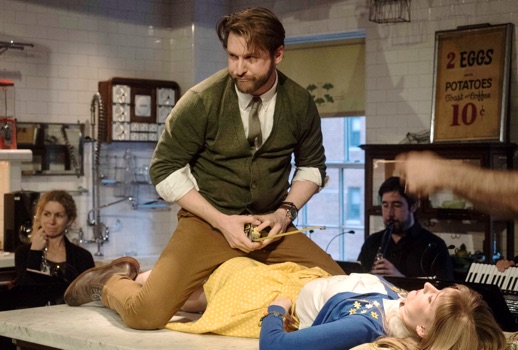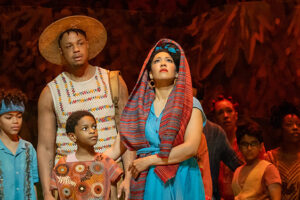

Some have already been discussed here at Parterre: John Yohalem visited the Vertical Player Repertory, while Patrick Clement James reviewed both Regina Opera and Opera Upper West.
This week it was my turn to explore the festival by attending two relatively rare works from the opposite ends of the 18th century: operamission presented Handel’s 1711 Rinaldo, while On Site Opera gave the North American premiere of Marcos Portugal’s La pazza giornata o sia Il Matrimonio di Figaro composed in 1799.
In 2012 Jennifer Peterson and operamission launched an ambitious project to perform all of Handel’s operas in chronological order with a rather wonderful production of Almira. Subsequent revivals of Rodrigo and Agrippina also proved worthy if rougher musically. Rather than stage Rinaldo, Handel’s spectacular depiction of love and heroism during the Crusades, the opera was given in concert at Merkin Concert Hall on Tuesday evening and proved that 305 years after it conquered London it can still be a powerful crowd-pleaser.
Fate seems to have decreed that I see Rinaldo only every sixteen years: in 1984 I eagerly took a Greyhound bus to Chicago to hear Marilyn Horne, Benita Valente and Samuel Ramey perform it. As Chicago wasn’t part of the Met tour, Lyric brought in the Rinaldo cast for a concert performance with the happy addition of Carol Vaness as Armida—her only time in the role opposite Horne.
Back then I didn’t know to object to the appalling musical edition Horne always used, so I had wonderful time, as I did when in 2000 David Daniels and Christine Goerke starred in the high point of New York City Opera’s wildly uneven Handel cycle.
Operamission’s young American singers displayed admirable stamina in an exceptionally full edition that lasted nearly three-and-three-quarter hours including just a short intermission. If they wielded less star power than my previous Rinaldo casts, by and large they sang with style and élan. This was not an evening for countertenor-haters (if they still exist) as four specimen tackled a majority of the score: 19 (!) da capo arias.
While Rinaldo was performed more often than any of his other operas during his lifetime, it’s far from Handel’s most focused or skillful work. The secondary alto characters of Eustazio and Goffredo get five arias each, almost none of which propel the action forward. However, Andrew Rader (after a rough start) as the former and Nicholas Tamagna (a Rodrigo veteran) as the latter performed their many mostly extraneous arias exceptionally well.
Rader, Tamagna and Randall Scotting, the Rinaldo, all displayed warm round decidedly unhooty voices, admirably even from top to bottom. If anything, one might complain there wasn’t enough contrast between the three singers. Scotting, fresh from Odyssey Opera’s production of Gluck’s Ezio, initially seemed a bit tentative, possibly saving himself for the daunting challenge of the end of the first act where Rinaldo has three out of the final four arias, beginning with the magnificent lament “Cara sposa” and ending with the whirlwind bravura showpiece “Venti, turbini.”
His florid singing there and elsewhere was secure but lacked the incisive flair one wants in Rinaldo’s music. His performance in the second half was freer, but his correct, bland portrayal rarely offered much in the way of dramatic intensity, unlike Tamagna’s which always displayed a trenchant fervor in even his most formulaic music.

Malia Bendi Merad’s exceedingly modest Almirena began alarmingly small-voiced but warmed up nicely for her charming bird-song “Augelletti” with its trio of chirping recorders. As always, the sweetly touching “Lascia ch’io pianga” (cannily borrowed by Handel from his earlier Il Trionfo del Tempo e del Disinganno) later stopped the show. Soprano Lieve Buzard’s wan Sirena failed to make much of an impression while Biraj Bakakaty’s earnest Mago Christiano didn’t let the countertenor contingent down.
The period-instrument orchestra which had been the weakest factor of the operamission’s previous two offerings was on firmer form, mostly playing with unanimity and brio. Especially fine were Abigail Karr, the intrepid first violinist, bassoonist Andrew Schwarz, and cellist Ezra Seltzer who collaborated with Peterson in the recitatives and the numerous continuo arias.
Patrick Jones tackled with panache Handel’s wild harpsichord solos in Armida’s “Vo’ far Guerra,” and the four natural trumpets lent a thrillingly brazen fire to the third act’s recurrent battle music. One hopes that operamission will respond equally well to the quieter bucolic world of Il Pastor fido when it moves on to its next challenge.
Last year On Site Opera presented Paisiello’s Il Barbiere di Siviglia, the first installment of its alternative Beaumarchais trilogy.
On Wednesday it moved onto the next chapter with Portugal’s virtually unknown opera about Figaro’s wedding. While the work proved only a pale imitation of the Mozart’s masterpiece written some thirteen years earlier, Eric Einhorn’s marvelously detailed immersive production–performed with infectious sparkle by a superb cast–made it a worthwhile adventure.
Audience members arriving early at the eclectically decorated brownstone “632 on Hudson” were invited to explore the Almaviva household as it prepared for the day’s nuptials. The Count greeted me and inquired if I was a friend of Figaro’s, while later Susanna betrayed to me more than a hint of nervousness about how the wedding day would play out. The audience eventually ended up snugly spaced around the kitchen observing Figaro as he busily measured his new quarters, while the seven-piece orchestra seated behind him patiently waited for conductor Geoffrey McDonald’s first downbeat.
One of On Site’s great strengths is the enviable intimacy of its approach–one is rarely more than a few feet from the singers all of whom performed with gratifying naturalness and admirable restraint (no clichéd buffo mugging, thank goodness). For the second act, we relocated downstairs to the Countess’s intimate boudoir which eventually filled up with the eight of the cast’s ten members. The third act took place a short distance from there in front of an imposing fireplace which was later decorated with a few “potted palms” to evoke the final act’s garden.
It may be difficult to fully judge the score as it had been cut to a roughly two-hour running time. All of the secco recitatives were omitted in favor of spoken dialogue (adapted by Joan Holden) which was delivered with flair by the cast. Anyone familiar with da Ponte’s libretto will discover no surprises in Gaetano Rossi’s version for Portugal which almost slavishly follows the earlier work. In fact, that was the evening’s biggest problem: because Portugal’s opera so closely follows Mozart’s, it was impossible not to be mentally comparing the two—always to Portugal’s detriment.
As most of its musical language comes directly out of late-18th century opera buffa, Portugal’s Figaro work was a perfect sequel to Paisiello’s Barbiere. The ensembles bustle with lots of energy but rarely evolve into something memorable. Most of the arias are terse and plain, the exceptions being Susanna’s pair.

Camille Zamora brought touching pathos to the Countess though Portugal and Rossi showed little interest in her character, and baritone Jesse Blumberg was a lively, mercurial Figaro. But the evening was dominated by its master, tenor David Blalock as a swaggeringly confident yet faintly ridiculous Count. Blalock, who also sang the Count in On Site’s Barbiere, handled the score’s most florid part with commanding charisma if crumbling self-possession. Ryan Kuster blustered effectively as the bass-baritone Basilio but David Langan hadn’t much do as Bartolo.
The imposing mezzo Margaret Lattimore, who recently shone at the Met as Mozart’s Marcellina, lent her sharp comic timing to Portugal’s mother-in-waiting. Like Houser, sprightly soprano Melissa Wimbish, so winningly androgynous as Cherubino, sounded pinched on top. Booming bass-baritone Antoine Hodge excelled in the comic business Einhorn supplied for both Antonio, the fussy gardener, and Gusmano, this Figaro’s sleepy version of Don Curzio.
Initially, the drastically reduced orchestration for violin, cello, clarinet, oboe, accordion, and classical and Portuguese guitar sounded disconcertingly thin but one soon got used to its unusual textures, while McDonald’s confident and breezy conducting ensured a tight ensemble even when the singers had no way to see him.
On Site’s collaboration with 632 on Hudson made for an unusually involving evening, although a short intermission mid-way wouldn’t have been amiss. Despite Portugal’s occasionally arid score, this keen, clever Figaro was a joy but one tempered by the knowledge that an audience of just 50 per performance would be enjoying it. One hopes that next summer’s concluding Beaumarchais production of Milhaud’s La Mère Coupable will be housed in a venue accessible to a larger public.
One of my favorite things about On Site is that it performs its works in English—Gilly French and Jeremy Gray provided the pert translation for Figaro. No doubt moving from space to space would have made titles impossible anyway, but it was a pleasant change from LoftOpera’s Le Comte Ory, for example, to simply pay attention to the singers rather than to constantly strain to read the poorly positioned English text.
A number of events remain in New York Opera Fest and next week the reborn New York City Opera presents the long-awaited local premiere of Catán’s Florencia en el Amazonas.
When the Met season ends, clearly opera is just getting going around the city’s five boroughs.
Photos of On Site Opera: Pavel Antonov.























Comments